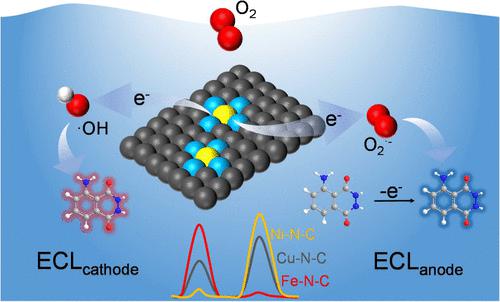当前位置:
X-MOL 学术
›
J. Am. Chem. Soc.
›
论文详情
Our official English website, www.x-mol.net, welcomes your feedback! (Note: you will need to create a separate account there.)
Regulating Reactive Oxygen Species over M–N–C Single-Atom Catalysts for Potential-Resolved Electrochemiluminescence
Journal of the American Chemical Society ( IF 15.0 ) Pub Date : 2024-04-17 , DOI: 10.1021/jacs.4c02986 Yan Zhou 1 , Yu Wu 1 , Zhen Luo 1 , Ling Ling 1 , Mengzhen Xi 1 , Jingshuai Li 1 , Liuyong Hu 2 , Canglong Wang 3 , Wenling Gu 1 , Chengzhou Zhu 1
Journal of the American Chemical Society ( IF 15.0 ) Pub Date : 2024-04-17 , DOI: 10.1021/jacs.4c02986 Yan Zhou 1 , Yu Wu 1 , Zhen Luo 1 , Ling Ling 1 , Mengzhen Xi 1 , Jingshuai Li 1 , Liuyong Hu 2 , Canglong Wang 3 , Wenling Gu 1 , Chengzhou Zhu 1
Affiliation

|
The development of potential-resolved electrochemiluminescence (ECL) systems with dual emitting signals holds great promise for accurate and reliable determination in complex samples. However, the practical application of such systems is hindered by the inevitable mutual interaction and mismatch between different luminophores or coreactants. In this work, for the first time, by precisely tuning the oxygen reduction performance of M–N–C single-atom catalysts (SACs), we present a dual potential-resolved luminol ECL system employing endogenous dissolved O2 as a coreactant. Using advanced in situ monitoring and theoretical calculations, we elucidate the intricate mechanism involving the selective and efficient activation of dissolved O2 through central metal species modulation. This modulation leads to the controlled generation of hydroxyl radical (·OH) and superoxide radical (O2·–), which subsequently trigger cathodic and anodic luminol ECL emission, respectively. The well-designed Cu–N–C SACs, with their moderate oxophilicity, enable the simultaneous generation of ·OH and O2·–, thereby facilitating dual potential-resolved ECL. As a proof of concept, we employed the principal component analysis statistical method to differentiate antibiotics based on the output of the dual-potential ECL signals. This work establishes a new avenue for constructing a potential-resolved ECL platform based on a single luminophore and coreactant through precise regulation of active intermediates.
中文翻译:

调节 M-N-C 单原子催化剂上的活性氧以实现电位分辨电化学发光
具有双发射信号的电位分辨电化学发光 (ECL) 系统的开发为复杂样品中准确可靠的测定带来了巨大希望。然而,此类系统的实际应用受到不同发光体或共反应物之间不可避免的相互作用和不匹配的阻碍。在这项工作中,我们首次通过精确调节M-N-C单原子催化剂(SAC)的氧还原性能,提出了一种采用内源溶解O 2作为共反应物的双电位分辨鲁米诺ECL系统。利用先进的原位监测和理论计算,我们阐明了通过中心金属物种调节选择性有效激活溶解的 O 2的复杂机制。这种调制导致羟基自由基 (·OH) 和超氧自由基 (O 2 ·– ) 的受控生成,随后分别触发阴极和阳极鲁米诺 ECL 发射。精心设计的Cu-N-C SAC 具有适度的亲氧性,能够同时生成·OH 和O 2 ·-,从而促进双电位分辨ECL。作为概念验证,我们采用主成分分析统计方法根据双电位 ECL 信号的输出来区分抗生素。这项工作通过精确调控活性中间体,为构建基于单一发光体和共反应物的潜在解析 ECL 平台开辟了一条新途径。
更新日期:2024-04-17
中文翻译:

调节 M-N-C 单原子催化剂上的活性氧以实现电位分辨电化学发光
具有双发射信号的电位分辨电化学发光 (ECL) 系统的开发为复杂样品中准确可靠的测定带来了巨大希望。然而,此类系统的实际应用受到不同发光体或共反应物之间不可避免的相互作用和不匹配的阻碍。在这项工作中,我们首次通过精确调节M-N-C单原子催化剂(SAC)的氧还原性能,提出了一种采用内源溶解O 2作为共反应物的双电位分辨鲁米诺ECL系统。利用先进的原位监测和理论计算,我们阐明了通过中心金属物种调节选择性有效激活溶解的 O 2的复杂机制。这种调制导致羟基自由基 (·OH) 和超氧自由基 (O 2 ·– ) 的受控生成,随后分别触发阴极和阳极鲁米诺 ECL 发射。精心设计的Cu-N-C SAC 具有适度的亲氧性,能够同时生成·OH 和O 2 ·-,从而促进双电位分辨ECL。作为概念验证,我们采用主成分分析统计方法根据双电位 ECL 信号的输出来区分抗生素。这项工作通过精确调控活性中间体,为构建基于单一发光体和共反应物的潜在解析 ECL 平台开辟了一条新途径。



























 京公网安备 11010802027423号
京公网安备 11010802027423号